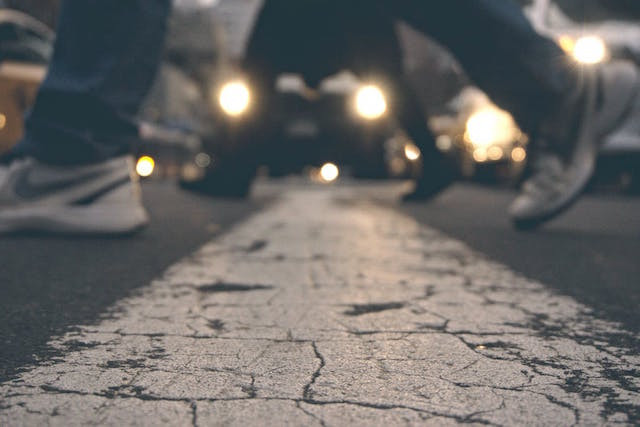Some media focus has been put recently on recurrent news of people crossing the street and being hit by drivers. Considering recent studies, time has come to question the official ‘Gitt Sichtbar’ road safety campaign for dark winter months.
This will not be about the few people hit at night on open country roads without sidewalks, but about those who simply wanted to cross the street inside lit villages and cities. Some were even using official crossings, but that did not prevent a collision with a car.
Over a century ago, people were already killed by motorists. In that time, the fault was clearly put on the speeding driver. Many went to jail.
Then cars became increasingly popular. To ease the moral remorse problem of drivers hitting a pedestrian, lobbyists of a growing industry successfully developed the ‘jaywalking’ narrative. In a few years’ time, the blame for collisions was completely shifted to the vulnerable road users, exception made for those using crossings. Already existing in Roman times(1), modern crosswalks were massively installed around the world from the 1930s on.
Things are in fact simple: road safety and speed do exclude each other. If no car was allowed to drive faster than 20km/h, we would have “Vision Zero” immediately. Of course, nobody is seriously asking for this. So we have to accept that crossings with or without traffic lights are dangerous places, especially for older people(2) who require more time to cross. As the ability of a body to recover from trauma fades with age, it was of no surprise that the two pedestrians who paid with their lives last December were both 75+ years old.
Speed limits on every single street or road are defined by lawmakers and are often a matter of debate. In past years, it became increasingly visible in statistics that vulnerable road users do not benefit to the same extent from technical progress as the drivers and passengers of motor vehicles. Therefore, nowadays road safety, lowering speed limits in cities from 50 to 30km/h is clearly recommended, but virtually never applied to main roads. Survival rates of pedestrians would be higher, we would have fewer cases of severe injuries.
Existing speed limits are unaffected by seasons or availability of daylight. Twilight conditions induce drivers to be too confident about good visibility and not to slow down as they should. Although statistics show that in dark winter time pedestrians are more often hit by cars, temporarily lowering speed limits to adapt to low visibility and road conditions has in the past unsurprisingly been ruled out. So another ‘solution’(3) had to be found.
Despite the facts that speed inside cities and villages narrows the visual focus of drivers and that there is no known study clearly proving that wearing high visibility gear would really help avoid collisions with vulnerable road users, the latter narrative has been developed in many countries and pushed with campaigns (‘Gitt Sichtbar’ in Luxembourg). A recent study(4) indicating that the visual perception of drivers in fact physiologically discriminates vulnerable road users, is definitely showing absurdity of the high visibility gear and clothing theory. That concept of inattentional blindness means that the driver looks, but that his brain does not identify smaller shapes with the same reliability as bigger vehicles.
Traffic volumes at rush-hour require driver’s undivided attention. As stopping at a crossing for a person to cross did reportedly lead to follow up crashes, the extent of drivers’ responsibility cannot be emphasised enough. Modern car infotainment systems with ever increasing display sizes are a massive source of distraction to drivers not well trained or used to properly looking at what is happening on the street. Finally, it is a still ignored and rarely enforced psychological reality that a minority of drivers obviously have antisocial behaviour(5), a fact that does matter a lot when they meet vulnerable road users.
Safety can only come from the focused and caring driver, and foremost his or her use of the car brakes. Stop the excuses: ‘Kuckt a bremst och!’, look properly and slow down!
Jean Schmit is known as a cycling and walking advocate on his Twitter account @luxembourgize
Notes:
(1) Poehler, Eric: The Traffic Systems of Pompeii, Oxford University Press, United Kingdom, 2017.
(2) Tournier, Isabelle; Dommes, Aurélie; Cavallo, Viola: Review of safety and mobility issues among older pedestrians [INSIDE, University of Luxembourg / LEPSIS, IFSTTAR, France]. In: Accident Analysis and Prevention 91 (2016) pp. 24–35.
(3) Patterson, Stephanie [with Mikael Colville-Andersen]: Traffic Safety Orgs Speak for Themselves - Not the Rest of Us. 06 November 2017. On-line: The blog of Copenhagenize Design Company
(4) Pammer, Kristen; Sabadas, Stephanie; Lentern, Stephanie: Allocating Attention to Detect Motorcycles: The Role of Inattentional Blindness. In: Human Factors: The Journal of the Human Factors and Ergonomics Society, Vol 60 (2017), Issue 1, pp. 5 – 19.
(5) Bushman, Brad J. [The Ohio State University, USA]; Steffgen, Georges [Institute for Health and Behavior, University of Luxembourg]; Kerwin, Thomas; Whitlock, Tyler; Weisenberger, Janet M.: “Don’t you know I own the road?” The link between narcissism and aggressive driving. In: Transportation Research Part F: Traffic Psychology and Behaviour, Volume 52 (January 2018), pp. 14-20.
